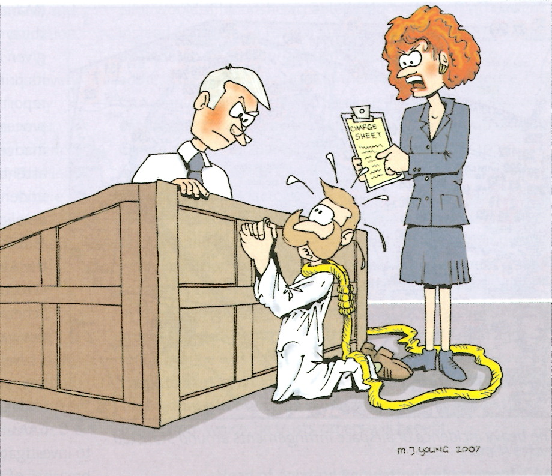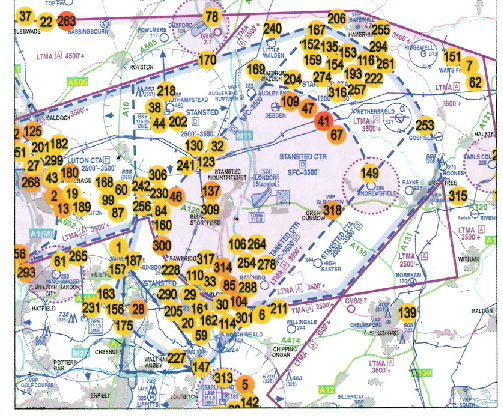Unauthorised Infringment of Controlled Airspace
Unauthorised Infringement of Controlled Airspace
THE PENALTIES
This is what the enforcers at the CAA do with GA pilots who infringe controlled airspace
An easy trip
The day’s task was an easy one. A quick trip over to Le Touquet to meet some friends for lunch and back home by six in time for dinner. The forecast was good with a line of thunderstorms having passed through an hour or so earlier. If he caught them up it would be easy to see them coming and give a wide berth. Having left the busy ATZ and levelled off at 2150ft to provide a little separation from the rather too well used 2,300—2,400ft around the bottom of the London TMA, he settled back for a pleasant flight. The Cherokee Arrow was a nice one. All the needles and dials were pointing just where they were supposed to be (why doesn't it happen when you have an examiner on board?) and time could be given to look out for anyone else transiting through the choke point between the Luton and Heathrow Control Zones. What a relaxed way to spend a day off. Too relaxed probably. Despite having flown the route often a glance at the NDB suddenly put paid to the good times. In the next few seconds,the realisation that he was in the Heathrow Control Zone without a clearance brought with it a flood of issues.The right hand felt an almost irresistible urge to select the transponder to standby while the urge to turn left and attempt to dive down below radar cover to avoid being traced was almost as strong. At the same time thoughts of ridicule by colleagues and others once the word got out were surpassed by dread of a visit from the heavy boys of the CAA followed by a court case, undoubted conviction and a fine.
Unauthorised infringements of controlled airspace continue to prove a challenge to all who operate and regulate UK aviation. Each infringement represents the potential for a "single catastrophic event” which, at its worst, carries with it the significant risk of loss of life. Despite all the efforts to achieve a solution, the number of unauthorised penetrations of UK controlled airspace reported to the CAA under the Mandatory Occurrence Reporting Scheme continue to rise. Most of the readers of this article will be aware of the CAA sponsored “On Track" initiative designed to try to identify problem areas and recommend possible solutions to the issue of airspace infringement. However, as was certainly in the front of the Arrow pilot's mind, even if a collision does not result there can certainly be other very serious outcomes. Nevertheless, it has been suggested in some quarters that fear of prosecution is inhibiting some pilots from reporting infringements and thus depriving others of the lessons that could be learned. The following paragraphs are an explanation of current CAA prosecution policy in relation to airspace prosecution in order to address those concerns.
 Reggie Bender on the CAA carpet again. |
The UK's Air Navigation Order and the Rules of the Air Regulations form part of criminal law. Breach them and you risk, if convicted, a fine and possible imprisonment.The CAA takes all reports that it receives of alleged breaches of Air Navigation legislation very seriously. As a prosecuting authority in its own right it can and does pursue appropriate cases through the courts. However,the CAA is also a very strong advocate of an open and fair reporting culture and, in line with that philosophy, has operated the MOR (Mandatory Occurrence Reporting) Scheme for over thirty years. Successive Chairmen of the CAA have given an undertaking that in operating the Scheme its primary concern is to secure free and uninhibited reporting and that it will not be its policy to institute proceedings in respect of unpremeditated or inadvertent breaches of the law which come to its attention only because they have been reported under the Scheme, except in cases involving dereliction of duty amounting to gross negligence. This is now enshrined in UK law under Article 142 of the Air Navigation Order 2005 and as a European Directive. Details and guidance regarding MOR Scheme can be found in the document section at www.caa.co.uk under publications as CAP 382.
Nevertheless, some cases of airspace infringement appear so serious that, in addition to being reported under the MOR Scheme, they are also notified to the CAA’s Enforcement Department which is established to investigate and, where appropriate, prosecute alleged breaches of Air Navigation legislation. Reports can be submitted from a variety of sources but those relating to infringements usually come from the air traffic controllers of the airspace concerned or the operators of the various types of restricted airspace. As can be seen from the attached table only a small percentage of infringement events are referred to ARE but that is small comfort to those involved.
 The heavy incidence of airspace infringements around Stansted. |
Prosecution and its alternatives
ARE is required to operate in accordance with the legislation and procedures applicable to most UK law enforcement agencies. Where there appears to be a case to answer, an investigating officer will obtain evidence working in line with the Police and Criminal Evidence Act.
| It will not be its policy to institute proceedings in respect of unpremeditated or inadvertent breaches of the law which come to its attention only because they have been reported under the Scheme ... |
During the process the pilot involved will be contacted, presented with the evidence gathered so far and given the opportunity to give a statement. He or she is under no obligation to do so and can consult a lawyer or take legal advice at any time. Once all the evidence is gathered, the report is submitted to the Head of ARE who considers, after consultation with others if necessary, whether to submit the case for prosecution. Any decision to prosecute is taken in line with the Code for Crown Prosecutors.This requires that, before issuing a summons, there must be sufficient evidence to provide a realistic prospect of conviction against each defendant and that it must be in the public interest to bring a prosecution. In the case of an airspace infringement, given the very serious potential, the public has a right to expect that every effort should be made to prevent a recurrence. This may involve prosecution in some cases. However, it has never been the case in the UK that all suspected criminal offences must automatically be the subject of prosecution. The Head of ARE has,therefore, some leeway in the decision. Where there is proof that an infringement was deliberate or premeditated or the result of negligence or recklessness a prosecution will almost always follow. However, if the infringement was as the result of a genuine mistake or misunderstanding and no harm or loss resulted, a prosecution is less likely to be needed. Whilst every case must, of course, be judged on its own merits, where a pilot who has not come to the attention of ARE for any previous, similar incident, infringes, even after completing a full pre- flight briefing but then calls the appropriate ATC unit or D&D cell immediately upon realising his predicament, it is virtually guaranteed that no prosecution will follow. The pilot would, if he or she accepted responsibility for the event, instead, be offered a Formal Caution with the condition that he undergo an appropriate period of flight training to address the issues identified. If there were no recurrence, the CAA would consider the matter closed. Retraining is also one of the methods used by the Safety Regulation Group of the CAA to address airspace infringements and forms an important part of the CAA wide initiative to address airspace incursion counsel factors.
The CAA is convinced that airspace incursions remain an on going and constant threat to airspace safety within the UK with prevention rather than punishment the favoured option to address the issue. This view is also shared, I can assure you, by the Cherokee pilot. He left the transponder on and didn’t stupidly dive away but rather reassessed the situation and found that he was on track. After a few miles the NDB gave up trying to alert him to the Cbs off to the north and all was well. During those few seconds, however, he certainly learned a lesson from which, he trusts, others will benefit.
Ian Weston
Head of Aviation Regulation Enforcement, CAA.















